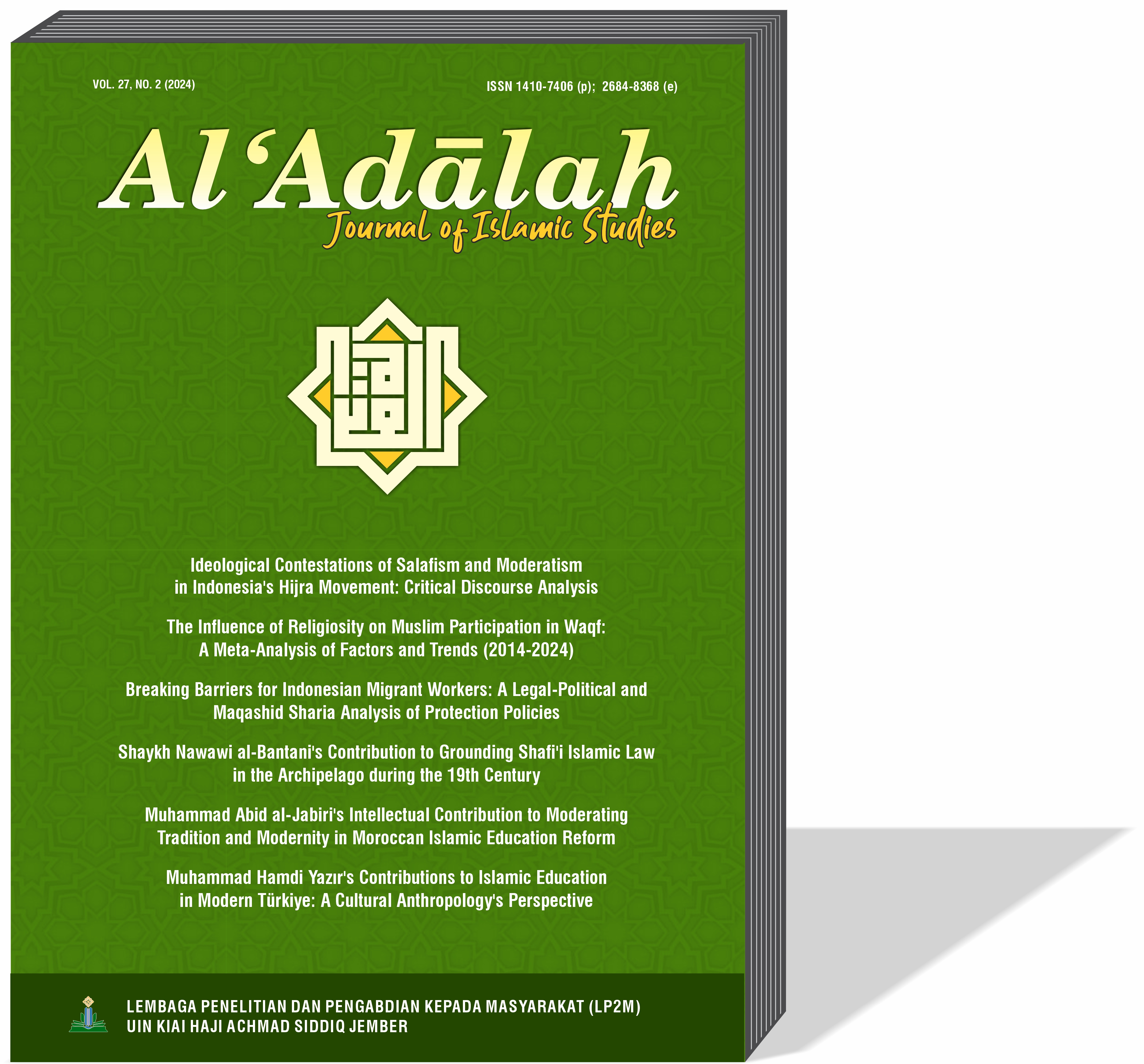Ideological Contestations of Salafism and Moderatism in Indonesia's Hijra Movement: Critical Discourse Analysis
DOI:
https://doi.org/10.35719/aladalah.v27i2.531The new pattern of learning for Indonesian Muslims, preferring references to religious knowledge through digital media, provides opportunities for Salafi groups to propose their religious teaching and movements, such as through Islamic-based websites, to contend in religious discourse. Ultimately, Islam experiences ideological contestation, including the construction of the hijra movement through a socialized understanding of Islamic law. This article explores the discourse of the hijra movement applied Salafism using Norman Fairclough's critical discourse analysis, which focuses on text, practice, and socio-cultural analysis. Therefore, the research data includes affiliated online publications and religious practices observed in Salafism religious forums in Bogor, Depok, and Jakarta. The results demonstrated that the hijra movement through digital media has become a strategic arena for the Salafi group in disseminating the Puritan narrative among middle-class Muslims, while Moderatism prioritizes tolerance and pluralism. Salafi group succeeded in captivating these Muslims who preferred to acquire Islamic understanding through online media rather than traditional religious forums to profess Salafism even though of internal conflict within Salafism. This study highlights the need for strengthening digital literacy to investigate ideological interactions across diverse Islamic groups in digital spaces.
Downloads
References
Ahmad, M., Muniroh, S. M. & Nurani, S. (2021). Niqab, protest movement, and the Salafization of Indonesian Islam. QIJIS: Qudus International Journal of Islamic Studies, 9(2), 423–462. https://doi.org/10.21043/qijis.v9i2.8195
Aidulsyah, F. (2023). The rise of urban Salafism in Indonesia: The social-media and pop culture of new Indonesian Islamic youth. Asian Journal of Social Science, 51(4), 252–259. https://doi.org/10.1016/j.ajss.2023.07.003
Akmaliah, W. (2020). The rise of cool ustadz: Preaching, subcultures and the Pemuda Hijrah Movement. ISEAS Publishing.
Al-Bukhari, M. I. (2002). Shahih al-Bukhari. Dar ibn Katsir li Thiba'ati wan Nasyr wat Tauzi'.
Al-Buty, M. S. R. (1996). Al-Salafiyyah marhalah zamaniyyah mubarakah la madhhab Islamy. Dar al-Fikr.
Al-Farraj, A. Y. M. b. A.-H. (2007). Fatawa al-aimmah an-najdiyyah hawla qadhaya al-ummah al-mishriyyah. Maktabah al-Rushd Nashirun.
Al-Najdi, A. Q. A.-A. (2004). Al-duraru as-saniyati fi al-ajwabati an-najdiyati. Muassasah Fuad ba'inu lil Tajlid.
Al-Syaikh, S. b. A. A. (2015). Al-dalail fi hukmi muwalat ahl al-ishrak. Maktabah al-Himmah.
As-Suyuti, J. A.-D. (1998). Al-tawshih sharh al-Jami' al-Sahih. Maktabah al-Rushd.
Azra, A. (2019). Islam, politics and democracy in the Southeast Asia. Cambridge University Press.
Basha, A.-S. A. b. A.-S. H. (n.d.). Sidq al-khabar. Matba'ah Kaumain.
Bruinessen, M. V. (2013). Contemporary developments in Indonesian Islam: Explaining the "conservative turn". Institute of Southeast Asian Studies (ISEAS) Publishing. https://doi.org/10.1355/9789814414579
Durmaz, H., & Yogun, H. (2022). A critical discourse analysis of a visual image in Norman Fairclough’s CDA model. International Journal of Scholars in Education, 5(1), 25–33. https://doi.org/10.52134/ueader.1101763
El-Sharif, F. (2020). The rhetoric of twentieth-century Damascene anti-Salafism. Contemporary Levant, 5(2), 113–125. https://doi.org/10.1080/20581831.2020.1767400
Fairclough, N. (2003). Analysing discourse: Textual analysis for social research. Routledge.
Fansuri, H. (2023). On the road of hijra: Contesting identity through urban mobilities in contemporary Indonesian Muslims. Archipel, 105(3485), 115–139. https://doi.org/10.4000/archipel.3485
Febriansyah, D., & El-Alami, D. S. (2021). Moderate Islam vis-a-vis Salafism in Indonesia: An ideological competition. Walisongo: Jurnal Penelitian Sosial Keagamaan, 29(1), 55–78. https://doi.org/10.21580/ws.29.1.7212
Furaihan, J. I. (2002). Al-Ajwibah al-mufidah 'an as'ilati manahij al-jadidah. Dar al-Manhaj.
Hamudy, N. A., & Hamudy, M. I. A. (2020). Hijra movement in Indonesia: Shifting concept and implementation in religiosity. JSW (Jurnal Sosiologi Walisongo), 4(2), 1–16. https://doi.org/10.21580/jsw.2020.4.2.5784
Hanbal, A. I. (1995). Musnad Ahmad ibn Hanbal. Dar al-Hadith.
Hanifuddin, M. (2021, February 3). Konservatisme dan Islamisme dalam gerakan hijrah kontemporer di Indonesia. Islami.co (PT. Islami Digital Indonesia). https://islami.co/konservatisme-dan-islamisme-dalam-gerakan-hijrah-kontemporer-di-indonesia/
Hasan, N. (2006). Laskar jihad: Islam, militancy, and the quest for identity in post-new order Indonesia. Cornell University Press. https://doi.org/10.7591/9781501719226
Hegghammer, T. (2009). Jihadi Salafis or revolutionaries: On religion and politics in the study of Islamist militancy. Columbia University Press.
Heryanto, A. (2014). Identity and pleasure: The politics of Indonesian screen culture. Natio-nal University of Singapore Press.
Hoesterey, J. (2015). Rebranding Islam: Piety, prosperity, and a self-help guru. Stanford University Press. https://doi.org/10.1515/9780804796385
Hosen, N. (2016). Shari’a and constitutional reform in Indonesia. ISEAS–Yusof Ishak Institute.
Husein, F., & Slama, M. (2018). Online piety and its discontent: revisiting Islamic anxieties on Indonesian social media. Indonesia and the Malay World, 46(134), 80–93. https://doi.org/10.1080/13639811.2018.1415056
Ibn As-Syaikh, A. I. H. (2002). Fath al-majid li sharh Kitab al-Tawhid. Maktabah Dar al-Muayyad.
Ibtimes.id. (2020, April 24). Hijrah, kelas menengah, & selebriti: Kesalehan atau komoditas? https://ibtimes.id/hijrah-kelas-menengah-selebriti-kesalehan-atau-komoditas/
Iliev, A., Grizhev, A., & Petrovski, A. (2022). Ideology of modern Wahhabism. In Interna-tional scientific conference: 45 years higher education in the area of security. University St Kliment Ohridski (pp. 189–200). https://eprints.ugd.edu.mk/31795/
Ismail, R. (2021). Rethinking Salafism: The transnational networks of Salafi 'Ulama in Egypt, Kuwait, and Saudi Arabia. Oxford University Press.
Khamdan, M. (2015a). Bina damai terorisme. Parist (Paradigma Institute).
Makruf, J., & Asrori, S. (2022). In the making of Salafi-based Islamic schools in Indonesia. Al-Jami'ah: Journal of Islamic Studies, 60(1), 227–264. https://doi.org/10.14421/ajis.2022.601.227-264
Meijer, R. (Ed.). (2014). Global Salafism: Islam’s new religious movement. Oxford University Press. https://doi.org/10.1093/acprof:oso/9780199333431.001.0001
Nisa, E. F. (2018). Social media and the birth of an Islamic social movement: ODOJ (One Day One Juz) in contemporary Indonesia. Indonesia and the Malay World, 46(134), 24–43. https://doi.org/10.1080/13639811.2017.1416758
Nurhayati, A., Muhsin I., & Prabowo T. T. (2023). The convergence of Nahdlatul Ulama and Jamaah Tabligh traditions in Temboro Village, Magetan, East Java. IBDA': Jurnal Kajian Islam dan Budaya, 21(2), 221–240. https://doi.org/10.24090/ibda.v21i2.7797
Qomaruzzaman, B., & Busro. (2021). Doing hijra through music: A religious phenomenon among Indonesian musician community. Studia Islamika, 28(2), 385–412. https://doi.org/10.36712/sdi.v28i2.13277
Rijal, S. (2024). Pursuing hijra to Salafi path: urban Muslim youth and the quest for self-transformation in Indonesia. Cont Islam. https://doi.org/10.1007/s11562-024-00564-x
Sebastian, L. C., & Arifianto, A. R. (2017). From civil Islam towards NKRI bersyariah? Understanding rising Islamism in post-reformasi Indonesia. In Proceedings of the Third International Conference on Social and Political Sciences (ICSPS 2017) (pp. 301–316). Atlantis Press. https://doi.org/10.2991/icsps-17.2018.65
Sheikh, N. S. (2021). Making sense of Salafism: Theological foundations, ideological ite-rations, and political manifestations. Routledge.
Taymiyyah, I. (2004). Majmu' fatawa. Majma' Malik Fahd li al-Tiba'ah wa al-Nashr.
Taufik, M. (2020). Strategic role of Islamic religious education in strengthening character education in the era of Industrial Revolution 4.0. Jurnal Ilmiah Islam Futura, 20(1), 86–104. https://doi.org/10.22373/jiif.v20i1.5797
Whyte, S. A. (2022). Islamic religious authority in cyberspace: A qualitative study of Muslim religious actors in Australia. Religions, 13(69), 1–16. https://doi.org/10.3390/rel13010069
Wictorowicz, Q. (2006). Anatomy of the Salafi movement. Studies in Conflict & Terrorism, 29(3), 207–239. https://doi.org/10.1080/10576100500497004
Zahrah, M. A. (2009). Tarikh al-madhahib al-Islamiyyah fi al-siyasah wa al-'aqai’d wa tarikh al-madhahib al-fiqhiyyah. Dar al-Fikr al-‘Araby.
Downloads
Section
License
Copyright (c) 2024 Muh Khamdan, Wiharyani, Nadiah Abidin

This work is licensed under a Creative Commons Attribution-NonCommercial 4.0 International License.
This work is licensed under a Attribution-NonCommercial 4.0 International (CC BY-NC 4.0).

























 Al'Adalah licensed under Creative Commons Attribution-NonCommercial 4.0 International License.
Al'Adalah licensed under Creative Commons Attribution-NonCommercial 4.0 International License.